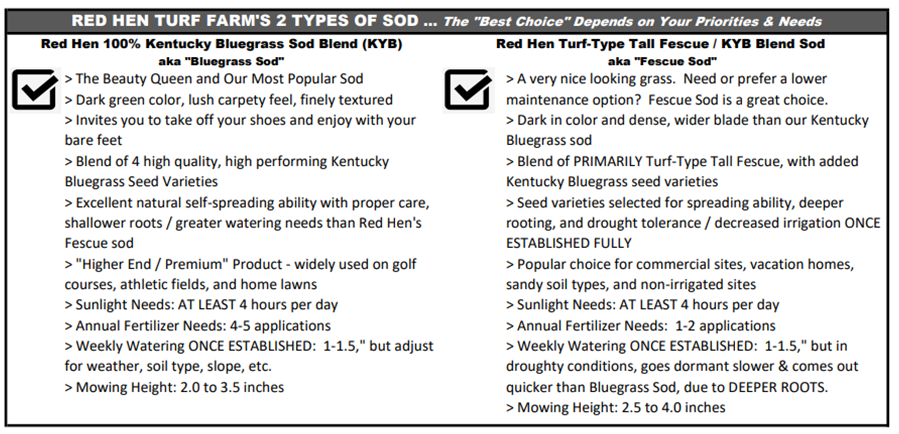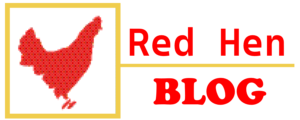Red Hen’s Two Choices for an INSTANT LAWN:
Red Hen’s Kentucky Bluegrass Sod vs. Red Hen’s Fescue Sod

Did you know that Red Hen Turf Farm produces and sells 2 kinds of sod?
Our Red Hen Bluegrass Sod is a beautiful, lush, and finely textured natural grass. It’s a blend of four high quality, top performing Kentucky bluegrass seed varieties, and is widely used on golf courses, athletic fields, and home lawns.
Our Red Hen Fescue Sod is MAINLY comprised of turf-type tall fescue and a bit of Kentucky bluegrass, and is grown for its superior density, dark color, and fine leaf texture. The fescues and Kentucky bluegrass in the mix provides lower irrigation requirements once established.
A very common misconception is that one of Red Hen’s types of sod is for SUN and one is for SHADE. That is NOT TRUE. Both types need at least 4 hours of direct sunlight daily to thrive.
Another common misconception is that one type is for dogs and one is not. Unfortunately, dogs are hard on grass and we can’t say that either type will hold up overtime with heavy dog use.
#redhenfaqs
RED HEN’S BLUEGRASS SOD
To dive in deeper, let’s start by focusing on Red Hen’s KENTUCKY BLUEGRASS SOD…
Our Kentucky Bluegrass Sod is by far (in our opinion) the more beautiful of Red Hen’s two options for turfgrass sod. It has a deep, emerald blue-green color with boat shaped blades and spreads quickly via rhizomes, (which are basically underground roots) to form a dense “knitted” type sod.
Kentucky bluegrass does best in full sun, which means it needs at least four or more hours of DIRECT sunlight daily to thrive. Kentucky bluegrass requires regular maintenance. Routine fertilization (4-5 applications each year) is key to maintaining this beautiful, lush turf.
Red Hen’s Bluegrass Sod has a shallower rooting system than Red Hen’s Fescue Sod. Because of its shallower rooting system, Red Hen’s Bluegrass Sod has lower tolerances for heat and drought. This is why it is important to follow recommended watering practices, especially in the heat of the summer … and even more so for sod that’s been installed within the last 12 months or less. Refer to Purdue’s Homeowner Publication, “Irrigation Practices for Homelawns” for guidance or give us a call.
Often in the spring, we hear the question “Why is my sod still brownish from winter, when my neighbors’ lawns are already greening up?” Well, it’s just nature being nature! Many varieties of Kentucky bluegrass tend to take a few extra weeks to “green up,” compared to fescues and ryegrasses. This is absolutely normal for Kentucky bluegrass, so it’s nothing to worry about.
One of the best things about Red Hen’s Bluegrass Sod is that — once it’s established – it has the ability to repair, spread and recuperate quickly from damage, as long as the area is smaller than a dinner plate and it’s being water right, mowed right and fertilized right.
Red Hen’s Kentucky Bluegrass Sod Maintenance Level:
- Medium to High.
- Water “RIGHT”. Keep in mind sod several growing seasons—about 12 months—for the roots to grow back and be considered “established.” Until then, watering needs may be higher, especially in certain areas of your yard (top of hills, near concrete, in full sun, etc.)
- Mow “RIGHT” – May-Sept 2.5-3 inches. Sept-Nov, gradually lower to final height of 2 inches. Mow often, avoid cutting more than 1/3 of the blade for deeper roots.
- Fertilize 4-5 times annually to keep pests and diseases at a minimum, and promote a thick, dense turf. Most important are 2 fall applications. Avoid fertilizing in the late spring and summer (warmer) months.
RED HEN’S FESCUE SOD
Now, let’s switch over to focusing on Red Hen’s FESCUE SOD…
Red Hen’s Fescue Sod is technically a blend of Turf-Type Tall Fescue with a small percentage of Kentucky bluegrass mixed in. All of the seed types in our Fescue Sod have a generally “deeper” root system once fully established.
Red Hen’s Fescue Sod is slightly lighter in green color when compared to our Kentucky Bluegrass Sod, but is still fairly dark in color compared to the types of fescue grasses that most people are familiar with. It is a deep-rooted, cool-season turfgrass that adapts well to a wide variety of soil types. The deeper rooting system allows Red Hen’s Fescue Sod to tolerate drought conditions better than our Kentucky Bluegrass Sod.
Many of our customers ask if we have “shade grass.” Our response is, “no grass likes shade.” However, our Fescue Sod is quite heat and drought tolerant and tends to do well, even in less-irrigated areas.
Typically, tall fescue grasses have a “bunch-style” growth habit without the ability to spread like Kentucky bluegrass’ natural rhizomatous root system. However, with the advent of this past decade’s turf technology, Turf-Type Tall Fescue is relatively self-repairing and able to spread due to pseudo-rhizomes.
The seed mix used to grow Red Hen’s Fescue Sod is MOSTLY Turf-Type Tall Fescue, which helps with installation and makes for quick establishment. Re-seeding Red Hen’s Fescue Sod is often still necessary in damaged areas, as the turf may tend to be “clumpy” as compared to the naturally tightly knit Kentucky bluegrass.
Since less water tends to be needed for Red Hen’s Fescue Sod, it is a common choice if you do not have an irrigation installed and desire a lower maintenance lawn.
It’s also a great fit for those with sandier soil types, especially when there is no irrigation / sprinkler system installed.
Red Hen’s Tall Fescue Sod Maintenance Level:
- Low to Moderate.
- Once established (which will take about 12 months or so), and the deeper roots of the Fescue Sod have grown back in, less irrigation is needed, compared to Kentucky Bluegrass Sod
- Mow “RIGHT” – May-Sept 2.5-3 inches. Sept-Nov, gradually lower to final height of 2 inches. Mow often, avoid cutting more than 1/3 of the blade for deeper roots.
- Once established, less fertilizer tends to be needed, as compared to Kentucky Bluegrass sod. Aim to fertilize 2-3 times annually. Most important are 2 fall applications. Avoid fertilizing in the late spring and summer (warmer) months.
Article last updated: 4/30/24
